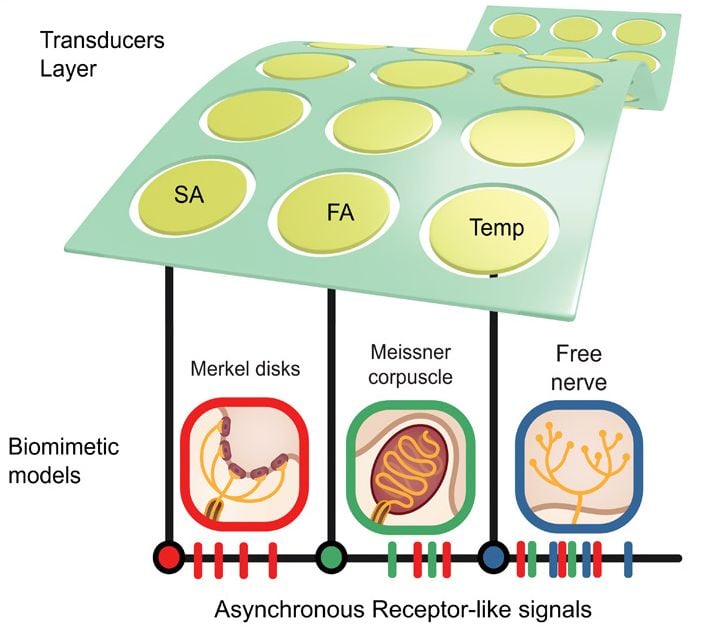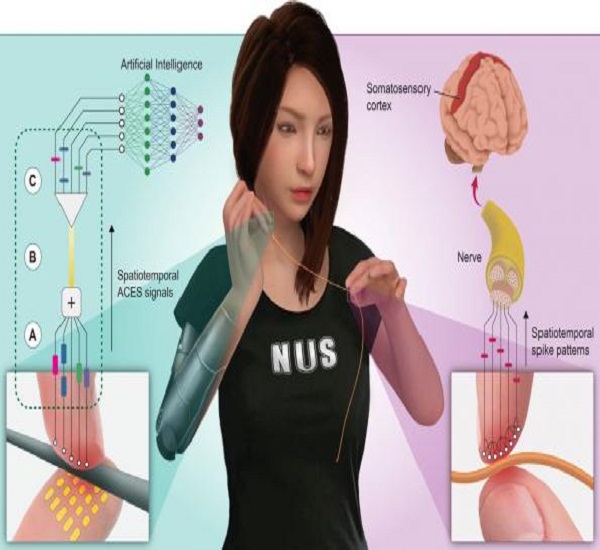Instead of relying on time-divisional multiple access to reconstruct a two-dimensional map of pressure / temperature distribution, the researchers chose an event-based signal architecture, where sensors asynchronously transmit data upon value changes. This is similar to the skin’s biological mechanoreceptors, their source of inspiration, which can fire spike signals asynchronously and form very precise spatiotemporal patterns that reach the brain at a constant latency for sensory interpretation.
Under the title “A neuro-inspired artificial peripheral nervous system for scalable electronic skins“, they disclosed in the Science Robotics journal a neuromimetic architecture which they call Asynchronously Coded Electronic Skin (ACES), theoretically capable of simultaneously transmitting the thermotactile information of 10,000 sensors, at a constant readout latency of 1ms.
In the ACES platform, each sensor or “ACES receptor” combines a resistive sensor, a microcontroller, and several passive components to perform the necessary signal conditioning. The receptor can then capture and transmit stimuli information asynchronously as “events” using electrical pulses spaced in time. Because each ACES receptor has its own pulse signature (designed to be transmitted in 1ms), multiple sensors can transmit concurrently and without specific time synchronization on the same conductor trace which will propagate the combined pulse signatures to a decoders. At the receiving end of a common electrical path, the decoder leverages a neural network to identify all the transmitting receptors by correlating the received pulses against the known temporal arrangement of pulses for each receptor’s signature. Prior 2D mapping of the receptors’ spatial distribution allows the decoder to match each stimuli to a physical location on the e-skin
This signal architecture is particularly robust against damage, as all the sensors can simply be connected through the same conductive substrate, regardless of their distribution or shape. Even cuts or regular tear and wear won’t accidentally disconnect them as it would be the case with matrix-based addressing, and “killing several receptors” won’t affect the signal of others.

sensory model, converting tactile stimuli into events that
are concurrently propagated.
The ACES platform also ensures individual receptors are plug and play, making it easy to combine multiple patches of ACES e-skins via a common conductive substrate, so they can be dynamically rearranged.
“This ACES signalling scheme is capable of propagating pulse signatures (events) from thousands of ACES receptors while preserving the relative time differences between the different tactile stimuli, which allows the rapid detection of object slippage, a key feature for grasp stability during in-hand object manipulation”, the authors wrote.
To prove their concept, the researchers designed several prototype arrays with up to 240 artificial mechanoreceptors, always maintaining a latency of 1ms while delivering a temporal signal precision under 60ns. They then designed a set of biomimetic models using the ACES platform to mimic the fast-adapting (FA), slow-adapting (SA), and temperature receptors of human skin by integrating flexible tactile and temperature transducers communicating through ACES pulse signatures. Because all three types of transducers were combined onto a single sheet of flexible conductor, the ACES platform could simultaneously detect thermal and tactile sensations when fitted onto a prosthetic hand.
The researchers have secured patents and are aiming to commercialize their electronic skin technologies. They are working on the design of an ASIC that would perform all of the ACES receptor functions in an optimized footprint, with programmable pulse signatures.
Source: eenewseurope










